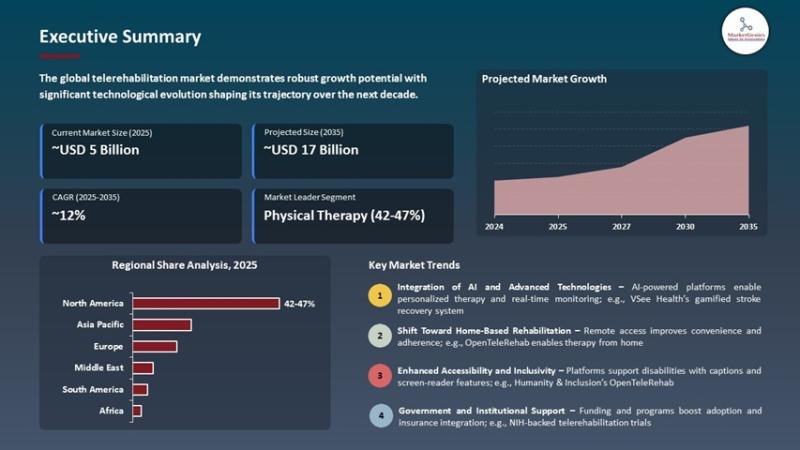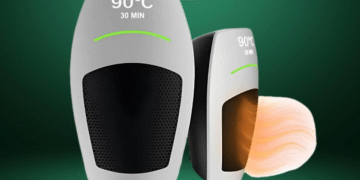
Telerehabilitation Market to Reach USD 17.6 Billion by 2035, Driven by AI Integration and Rise of Home-Based Therapy
Telerehabilitation Market projected to grow at a CAGR of 12.5% during the forecast period of 2025 to 2035
MarketGenics, a leading healthcare research and analytics company, announced a series of milestones in the rapidly expanding Telerehabilitation Market globally.
The market insights highlight technological advancements, accessibility of care, and hybrid rehabilitation models as central factors driving growth.
Get the Detailed Industry Analysis (including the Table of Contents, List of Figures, and List of Tables) – from the Telerehabilitation Market Research Report: https://marketgenics.co/press-releases/telerehabilitation-market-37132
Platform Upgrade – May 2025: Humanity & Inclusion upgraded its OpenTeleRehab platform with enhanced accessibility features, including screen-reader compatibility and multilingual captions, meeting WHO-ITU standards for inclusive rehabilitation services.
Clinical Trial Expansion – June 2025: VSee Health launched Phase 3 AI-powered gamified telerehabilitation trials for stroke recovery, aimed at improving therapy adherence and strengthening Medicare and commercial reimbursement prospects.
VR-Based Expansion – April 2025: XRHealth announced the expansion of its VR-based telerehabilitation platform into Asia Pacific through partnerships with hospitals in Japan and South Korea, offering multilingual rehab modules for post-stroke and orthopedic recovery.
To know more about the Telerehabilitation Market – Download our Sample Report: https://marketgenics.co/download-report-sample/telerehabilitation-market-37132
Telerehabilitation Market Forecast 2035
According to the report, the global telerehabilitation market is expected to grow from USD 4.8 Billion in 2025 to USD 17.6 Billion in 2035, registering a CAGR of 12.5% during the forecast period.
The growth is driven by:
Rising cases of chronic diseases and mobility-related conditions.
Increasing demand for AI-driven remote monitoring and personalized rehabilitation plans.
Shift toward home-based rehabilitation models, reducing hospital visits and improving patient engagement.
Expansion of wearable and IoT device integration for real-time therapy tracking.
For example, Hinge Health expanded its AI-powered digital musculoskeletal (MSK) care program in 2024, providing real-time corrective feedback through motion tracking, significantly improving therapy adherence and recovery outcomes.
Key Driver, Restraint, and Growth Opportunity Shaping the Global Telerehabilitation Market
Drivers – Aging Population and Remote Care Demand
With a growing geriatric population, there is heightened demand for rehabilitation services to address conditions such as arthritis, post-stroke impairments, and orthopedic disorders.
Telerehabilitation offers elderly patients the ability to receive therapy remotely, improving access and reducing the burden of travel.
In 2024, Reflexion Health launched the VeraHome platform, using motion-sensing avatars to guide elderly patients recovering from hip and knee replacements at home.
Restraints – Lack of Clinical Standards and Data Privacy Concerns
The absence of standardized clinical protocols for telerehabilitation creates inconsistency in treatment approaches across regions.
Data privacy issues remain a significant challenge as sensitive patient information is transmitted through digital platforms.
Companies like Motus, developing AI-based rehabilitation tools, face hurdles due to varying regulatory requirements and stringent telehealth compliance laws like HIPAA and GDPR.
Buy Now: https://marketgenics.co/buy/telerehabilitation-market-37132
Opportunities – Integration with Wearables and IoT
Combining telerehabilitation platforms with wearable devices and IoT technologies allows real-time tracking of therapy progress and precise patient feedback.
In 2024, SWORD Health introduced Digital Therapist+, which integrates wearable motion sensors with AI to guide musculoskeletal therapy, enhancing treatment outcomes and adherence.
This integration represents a major step forward in personalized and adaptive rehabilitation solutions.
Key Trend: Rise of Hybrid Rehabilitation Models
Post-COVID, healthcare providers are adopting hybrid models, blending in-person assessments with ongoing remote therapy sessions.
In 2024, RehabGuru partnered with NHS Trusts to implement hybrid models, enabling initial physical assessments in clinics, followed by remote therapy via digital platforms.
This approach enhances treatment compliance, patient satisfaction, and continuity of care.
Expansion of Global Telerehabilitation Market
“Physical Therapy Dominating Market Share”
The physical therapy segment holds the largest share of ~44% in 2025, driven by rising cases of musculoskeletal disorders, sports injuries, and post-operative care needs.
Cost-effective remote therapy is particularly beneficial for rural and underserved populations, reducing barriers to access.
Regional Analysis of Global Telerehabilitation Market
North America – Market Leader
North America dominates the market due to advanced healthcare infrastructure, high digital literacy, and strong reimbursement policies.
In 2024, computer vision and AI-based rehabilitation solutions were rolled out across U.S. clinics, enabling safe at-home post-operative recovery under clinician supervision.
Europe – Focus on Digital Integration
European nations are expanding telehealth platforms and cross-border healthcare policies, driving adoption of virtual rehabilitation services.
Asia Pacific – Emerging Growth Region
Rapid healthcare digitization in countries like Japan, South Korea, China, and India fuels high demand for remote rehabilitation solutions.
Partnerships between technology providers and hospitals are accelerating market expansion.
Get a preview of our Telerehabilitation Market Playbook – your guide to GTM strategy, competitive intelligence, supplier dynamics, and Consumer Behavior Analysis: https://marketgenics.co/playbook/telerehabilitation-market-37132
Recent Developments
May 2025: Humanity & Inclusion enhances OpenTeleRehab platform with global accessibility features.
June 2025: VSee Health launches Phase 3 gamified stroke rehabilitation trials powered by AI.
April 2025: XRHealth expands VR-based rehabilitation services into Asia Pacific markets.
2024: Hinge Health upgrades AI-driven motion tracking MSK therapy platform for improved recovery outcomes.
Prominent Players in the Telerehabilitation Market
Key players operating in the global telerehabilitation market include:
Hocoma, Kaia Health, MedBridge, Physitrack, Hinge Health, FitMi (Flint Rehab), Reflexion Health, RecoverX, and Other Key Players.
The market is moderately fragmented, with Tier 1 players like Hocoma, Kaia Health, and MedBridge leading innovation, while smaller companies focus on niche solutions such as gamified therapy and robotic-assisted rehabilitation.
About Us
MarketGenics is a global market research and management consulting company empowering decision makers across healthcare, technology, and policy domains. Our mission is to deliver granular market intelligence combined with strategic foresight to accelerate sustainable growth.
We support clients across strategy development, product innovation, healthcare infrastructure, and digital transformation.
Contact:
Mr. Debashish Roy
MarketGenics India Pvt. Ltd.
800 N King Street, Suite 304 #4208, Wilmington, DE 19801, United States
USA: +1 (302) 303-2617
Email: sales@marketgenics.co
Website: https://marketgenics.co
This release was published on openPR.
















